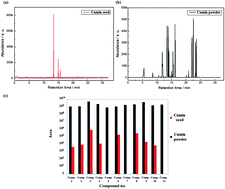Geographical provenience differentiation and adulteration detection of cumin by means of electronic sensing systems and SPME-GC-MS in combination with different chemometric approaches
Abstract
The detection of the aroma and flavour volatile compounds of spices is key in product quality control. Accordingly, it is necessary to develop new electronic sensing systems for food adulteration control and authenticity assessment for protecting customer's health. In this work, the capability of the E-nose and VE-tongue in combination with SPME-GC-MS to correctly discriminate between several cumin samples of different geographical origins and to detect their adulteration, by using unsupervised and supervised chemometric tools, was evaluated. Regarding the aroma profile, eleven volatile compounds were characterized by SPME-GC-MS; all of them were found in cumin powder while only eight are found in cumin seeds. The main volatile compounds detected were β-pinene, m-cymene, γ-terpinene, cuminaldehyde and cuminic alcohol, in different proportions depending on the cumin sample form (seed or powder). In summary, the results obtained are sufficiently encouraging as a starting point for the development of new electronic sensing systems with more improvement in the reliability of the sensor's performance as well as chemometric tools in order to deal with a complex dataset.


 Please wait while we load your content...
Please wait while we load your content...